 ,College of Physics and Engineering,
,College of Physics and Engineering, First author contact:
Received:2020-01-8Revised:2020-02-13Accepted:2020-02-26Online:2020-04-22

Abstract
Keywords:
PDF (863KB)MetadataMetricsRelated articlesExportEndNote|Ris|BibtexFavorite
Cite this article
Ji-Yang Li, Xin-Lei Li, Guo-An Yan. Single-photon quantum router based on asymmetric intercavity couplings. Communications in Theoretical Physics, 2020, 72(5): 055101- doi:10.1088/1572-9494/ab7ed5
1. Introduction
The scalable quantum information processing [1–9] in the fields of quantum communication and quantum computation is achieved based on quantum networks [10]. A quantum network is composed of the quantum nodes and quantum channels. Quantum nodes coherently connect different channels, in which the routers control the transport of signals in the different channels. In an efficient optical quantum network, photons are used as ideal information carriers due to their fast propagation speeds, stable coherence, and low dissipations. Recently, the rapid development of photon transport technology in coupled-resonator waveguide (CRW) systems [11–15] provides an ideal platform for single-photon quantum routing, in which the CRW is utilized as a quantum channel for optical signal transmission, and the quantum emitter coupled to the CRW is used to route photons to each channel. Currently, considerable attention has been paid to photon quantum routing that has been implemented in many systems including a whispering-gallery-mode resonator [16], quantum dot [17], cavity quantum electrodynamics [18–22], and optomechanical system [23].However, in the current routing system, the routing rate of the routers from the main channel to other channels is not more than 50% [18–20], which may limit its more potential applications. A high routing rate can achieve an efficient expected allocation of information between channels. Therefore, it is vital to design a quantum router with a high routing rate for a multi-channel quantum network. To address the problem, many proposals based on the chiral photon-emitter couplings in waveguide-emitter routers have been put forward recently [24–29]. However, in this work, we propose a single-photon routing scheme using the two one-dimensional CRWs with tunable asymmetric intercavity couplings and a three-level Λ-type atomic system. Compared with previous work, our proposed scheme can improve the transfer rate of a single photon from one quantum channel to another, and the maximum transfer rate can reach 100%. We also find that the present setup can be directly realized by the four resonators coupled by a coupler qutrit.
2. Model and Hamiltonian
The system under consideration is composed of two one-dimensional CRWs whose cavity modes are described by the creation operators ${a}_{x}^{\dagger }$ and ${b}_{x}^{\dagger }$(and subscript $j=-\infty ,\,\ldots ,\,+\infty $), and a three-level system characterized by a ground state $| g\rangle $, an intermediate state $| s\rangle $ and an excited state $| e\rangle $. The transition $| g\rangle \leftrightarrow | e\rangle $ is dipole-coupled to the cavity modes a0 and b0 with a coupling strengths of ga and gb. A classical field drives the transition $| s\rangle \leftrightarrow | e\rangle $ with the Rabi frequency Ω. For the two one-dimensional CRWs, we will focus on the case of asymmetric intercavity couplings. Here, we assume that all resonators in CRW−a(CRW−b) have the same frequency ωa(ωb), and the hopping energies ζa (ζb) between any two nearest-neighbor cavities in CRW−a(CRW−b) are the same, except two couplings(${\zeta }_{a}^{{\prime} }$ and ${\zeta }_{b}^{{\prime} }$)between the 0th and 1st resonates in the two one-dimensional CRWs. ${\lambda }_{a}(b)=({\zeta }_{a}^{{\prime} }(b)-{\zeta }_{a}(b))/{\zeta }_{a}(b)$ is introduced to denote the relation between ${\zeta }_{a}(b)$ and ${\zeta }_{a}^{{\prime} }(b)$ [30]. The model is schematically depicted in figure 1.Figure 1.
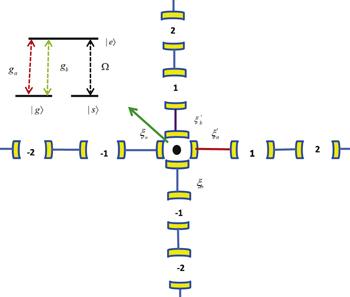 New window|Download| PPT slide
New window|Download| PPT slideFigure 1.Schematic of the single-photon quantum router in two channels made of two CRWs.
The Hamiltonian of the whole system is (setting ℏ=1)
For the photonic band inside the CRWs, the single photon incident with energy E is scattered elastically. Therefore, the particle either is propagated inside the cavity or is absorbed by the three-level atom system. This means that the stationary eigenstate of the full system is
Using the eigenequation $H| {\rm{\Psi }}\rangle =E| {\rm{\Psi }}\rangle $, we can obtain the discrete scattering equation
The wave functions in the asymptotic regions are given, respectively, by
3. Single-photon quantum router
To compare with previous research work, we first discuss the routing capability when ${\lambda }_{a}={\lambda }_{b}=0$, this case is the same as the single-photon quantum router scheme proposed by Zhou et al [18]. The quantum router can implement the routing capability regardless of turned on or turned off of the classical field, but the maximum conversion rate of the information carried by a single photon is only 50%. To visually express the conversion rate of a single photon in this case, in figure 2, we plotted the transmittance Ta, transfer rate ${T}_{u}^{b}+{T}_{d}^{b}$ and reflectance Ra as function of the incident energy E. Three different band configurations are presented.Figure 2.
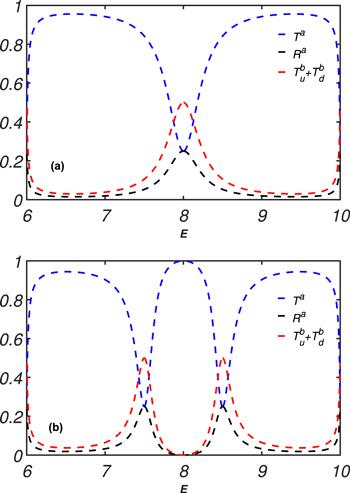 New window|Download| PPT slide
New window|Download| PPT slideFigure 2.(a)Ra, Ta and ${T}_{u}^{b}+{T}_{d}^{b}$ as a function of the energy of the incident wave when ωs=Ω=0; (b) Ra, Ta and ${T}_{u}^{b}+{T}_{d}^{b}$ as a function of the energy of the incident wave when Ω=0.5 and ωs=8. The remaining parameters are set as follows: ωa=ωb=ωe=8, ζa= ζb=1, λa=λb=0, and ga=gb=0.5.
For ${\lambda }_{a}\ne 0,{\lambda }_{b}=0$ and Ω=0, to study this mechanism, we plot the current flow of the photon in CRW−b in figure 3(a), which are described by the coefficients ${T}_{u}^{b}+{T}_{d}^{b}$. We find that when ${\lambda }_{a}\geqslant 0$, the transfer ${T}_{u}^{b}+{T}_{d}^{b}$ into CRW−b is limited to be no more than 50%, which has been examined in the previous schemes. But when λa<0, the transfer rate far more than 50%, and the peak transfer rate are centered at E=ωs. The width of the peak for the transfer rate ${T}_{u}^{b}+{T}_{d}^{b}$ is determined by the λa. The smaller the product λa is, the wider the peak is. When a classical field is turned on, we plot ${T}_{u}^{b}+{T}_{d}^{b}$ as a function of the energy of the incident wave in figure 3(b), except the classical field makes one dip be split into two dips, the conservation relation and the related scattering properties are the same as those in figure 3(a). In figure 4, we plot the transfer rate ${T}_{u}^{b}+{T}_{d}^{b}$ as a function of the energy of the incident wave when ${\lambda }_{a}=0,{\lambda }_{b}\ne 0$ and ${\rm{\Omega }}=0({\rm{\Omega }}\ne 0)$. We find that no matter what λb≥0 or λb<0, the transfer ${T}_{u}^{b}+{T}_{d}^{b}$ into CRW−b is limited to be no more than 50%, and other physical phenomena are the same as in figure 3.
Figure 3.
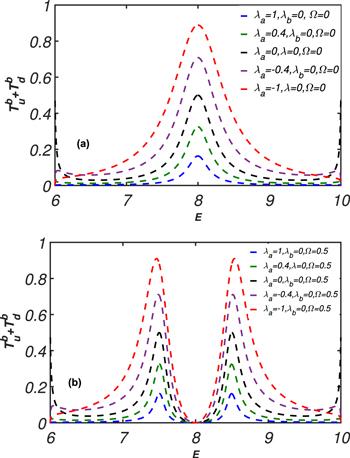 New window|Download| PPT slide
New window|Download| PPT slideFigure 3.(a) ${T}_{u}^{b}+{T}_{d}^{b}$ as a function of the energy of the incident wave when ωs=Ω=0; (b) ${T}_{u}^{b}+{T}_{d}^{b}$ as a function of the energy of the incident wave when ωs=8 and Ω=0.5. Other parameters are taken as ωa=ωb=ωe=8, ζa=ζb=1, ωs=8, and ga=gb=0.5.
Figure 4.
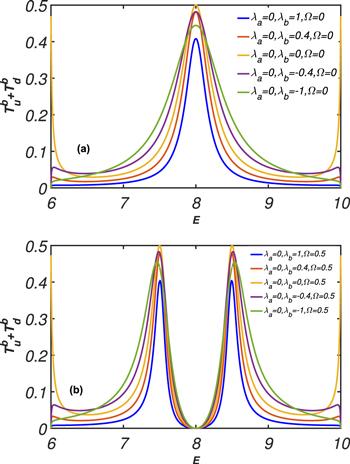 New window|Download| PPT slide
New window|Download| PPT slideFigure 4.${T}_{u}^{b}+{T}_{d}^{b}$ as a function of the energy of the incident wave when ωs=Ω=0; (b) ${T}_{u}^{b}+{T}_{d}^{b}$ as a function of the energy of the incident wave when ωs=8 and Ω=0.5. Other parameters are taken as ωa=ωb=ωe=8, ζa=ζb=1, and ga=gb=0.5.
We know from figures 3 and 4 that whether or not the classical field exists, only when λa<0, the transfer rate ${T}_{u}^{b}+{T}_{d}^{b}$ will far exceed 50%. To gain a deeper insight into the dependence of the photon routing capability on the two variables λa and λb, figure 5 displays the transfer rate ${T}_{u}^{b}+{T}_{d}^{b}$. As seen, the high transfer rate is located in the almost quadrant regions with negative values of the two variables, and their maximum values ${T}_{u}^{b}+{T}_{d}^{b}=1$ emerge in the center point ${\lambda }_{a}={\lambda }_{b}=-1$. So, it is possibly feasible to efficiently enhance the routing capability of the single photons between two channels by adjusting the inter-resonator couplings.
Figure 5.
 New window|Download| PPT slide
New window|Download| PPT slideFigure 5.(a)–(c) ${T}_{u}^{b}+{T}_{d}^{b}$ as a function of the energy of the incident wave when ωs=Ω=0; (d), (e) and (f) ${T}_{u}^{b}+{T}_{d}^{b}$ as a function of the energy of the incident wave when ωs= and Ω=0.5. Here, the chosen parameters ωa=ωb=ωe=8, ζa=ζb=1, and ga=gb=0.5.
4. Discuss and conclusion
The tunable coupling between two neighboring resonators can be realized by coupled single-mode superconducting transmission line resonators and a gap-tunable qubit. Consider a system composed of four resonators and a superconducting qutrit A with states $| 0\rangle ,| 1\rangle ,| 2\rangle $, for the four resonators each of which consists of N identical superconducting transmission line resonators, linked with each other through capacitors. The model is schematically depicted in figure 6. The four resonators coupled by a coupler superconducting qutrit may be used as a basic circuit block to build a two-dimensional quantum network for quantum information processing. This is exactly similar to the function of quantum routers in quantum networks. In other words, the quantum routers we propose can be implemented in superconducting circuits. For the model in figure 6, Yang et al [31] and Li et al [32] have verified its practicability, and the model has high fidelity for information transmission.Figure 6.
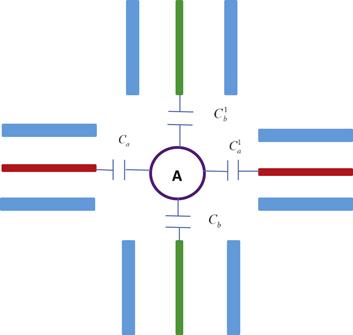 New window|Download| PPT slide
New window|Download| PPT slideFigure 6.Diagram of a superconducting qutrit A coupled capacitively to four one-dimensional coplanar waveguide resonators through ${C}_{a},{C}_{a}^{1},{C}_{b},{C}_{b}^{1}$, respectively.
In conclusion, we considered a system composed of two one-dimensional CRWs with two inter-resonator hopping coefficients that are designed to be tunable and a Λ-type atom which behaves as a quantum multichannel router. Whether the classical field exists or not, the quantum router we propose can implement the routing function. Compared with previous work, our proposed scheme can improve the transfer rate of a single photon from one quantum channel to another, and the maximum transfer rate can reach 100%. We also find that the present setup can be directly realized by the four resonators coupled by a coupler qutrit. Thus, we believe that the present investigation may open an approach for the realization of a large-scale quantum network.
Acknowledgments
This work is supported by the Project of Introduction and Cultivation for Young Innovative Talents in Colleges and Universities of Shandong Province.Reference By original order
By published year
By cited within times
By Impact factor
DOI:10.1103/PhysRevB.84.045310 [Cited within: 1]
DOI:10.1103/PhysRevLett.110.113601
DOI:10.1103/PhysRevLett.111.090502
DOI:10.1103/PhysRevA.89.042328
DOI:10.1103/PhysRevA.94.043839
DOI:10.1103/PhysRevLett.118.133601
DOI:10.1103/PhysRevLett.117.240501
DOI:10.1103/PhysRevLett.95.213001
DOI:10.1103/RevModPhys.89.021001 [Cited within: 1]
DOI:10.1038/nature07127 [Cited within: 1]
DOI:10.1103/PhysRevA.85.053840 [Cited within: 1]
DOI:10.1103/PhysRevA.84.063803
DOI:10.1103/PhysRevLett.101.100501
DOI:10.1103/PhysRevA.87.063821
DOI:10.1103/PhysRevA.85.043832 [Cited within: 1]
DOI:10.1364/OE.25.016931 [Cited within: 1]
DOI:10.1063/1.4922041 [Cited within: 1]
DOI:10.1103/PhysRevLett.111.103604 [Cited within: 3]
DOI:10.1103/PhysRevA.89.013805
DOI:10.1007/s11433-017-9059-3 [Cited within: 1]
DOI:10.1103/PhysRevLett.107.223601
DOI:10.1140/epjd/e2016-60724-6 [Cited within: 2]
DOI:10.1103/PhysRevA.85.021801 [Cited within: 1]
DOI:10.1103/PhysRevA.97.023821 [Cited within: 1]
DOI:10.1103/PhysRevA.97.062318
DOI:10.1364/OL.42.002914
DOI:10.1364/OE.24.019988
DOI:10.1103/PhysRevA.94.063817
DOI:10.1103/PhysRevA.99.033827 [Cited within: 1]
DOI:10.1007/s11128-019-2176-y [Cited within: 1]
DOI:10.1103/PhysRevA.87.022320 [Cited within: 1]
DOI:10.1103/PhysRevB.91.014515 [Cited within: 1]
